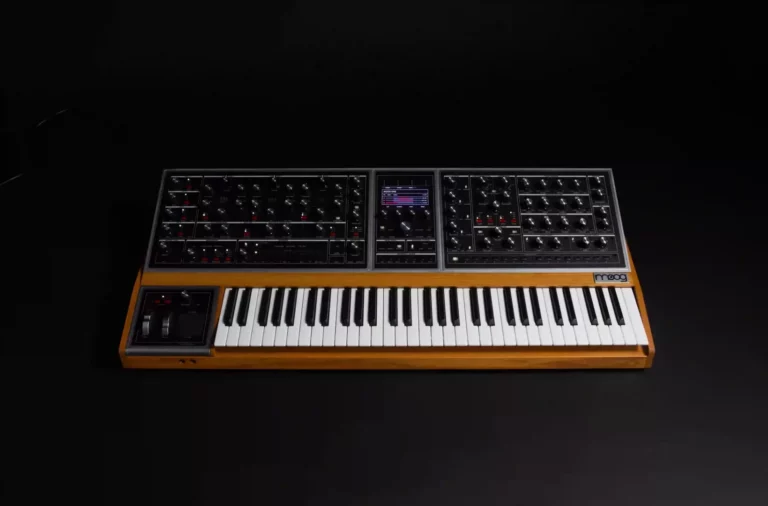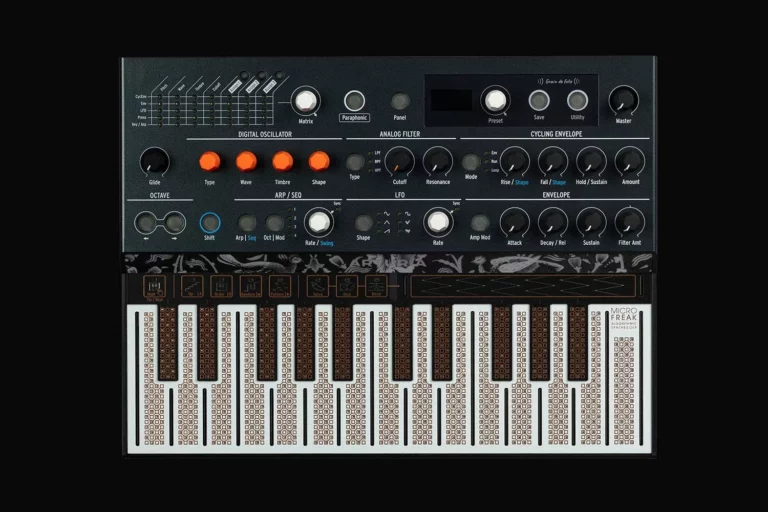
The Korg Nautilus is a powerful and versatile music workstation that offers a wide range of features for both professional and amateur musicians.
It is designed to be an all-in-one solution for composing, performing, and recording music, and it certainly covers all bases. In this review, we will examine some of the key features of the Korg Nautilus and compare the instrument to the older Korg Kronos.
The Korg Nautilus Full Review – The Best Workstation in 2024?
Overview
No products found.
This instrument has a sleek, modern design that is curved and attractive. It comes in 61-key and 73-key semi-weighted models or an 88-key model with weighted keys.
This 88-key model is the most pianistic option and provides the best overall feel for piano and Rhodes sounds and is the more expressive option due to its RH3 (Real Hammer 3) keybed.
The build quality of the Nautilus is also top-notch, with high-quality materials and attention to detail throughout.
While the 88-key model is fitted with sumptuous wooden end panels, the 61-key and 73-key models feature a sleek new chassis with swoopy curves that rise up from the bottom to the sides, conjuring the maritime design inspiration behind NAUTILUS.
It all adds up to an elegant, yet tour-tough instrument that looks as good as it sounds.
Korg Nautilus: Pros and Cons
| Pros | Cons |
|---|---|
| Offers much of the Kronos functionality in a more affordable package. | Long boot time (around 2 minutes) which can be problematic in situations like power cuts on stage. |
| High-quality and sheer amount of sounds available | 61-key model keybed might be considered lacking by some users, though this is subjective. |
| Impressive design, touchscreen, key-action, presets, effects, sequencer, and sampler. | Can be a steep learning curve as with all workstation-style pianos, though this is also subjective. |
The pros of the instrument are mainly the high quality and sheer amount of sounds available, plus the ability to compose and record with the sequencer.
Like the Kronos, one of the main downsides to this instrument is the long boot time (around 2 minutes). For home studio musicians, this is less of an issue, but on stage, it can present a small inconvenience at times.
Korg Nautilus Models

[Velocity sensitivity is supported. After-touch is not supported]
Korg Nautilus 88
88 key: RH3 (Real Weighted Hammer Action 3), A – C
Korg Nautilus 73
73 key: Natural Touch Semi-Weighted, C – C
Korg Nautilus 61
61 key: Natural Touch Semi-Weighted, C – C
Korg Nautilus Sounds
The Nautilus features the same sound engines as the Korg Kronos, which means it offers the same high-quality sounds and synthesis capabilities.
The SGX-2 piano engine produces highly realistic piano sounds, while the tonewheel organ sound engine creates authentic Hammond organ sounds.
The Nautilus also includes a wide range of Rhodes electric piano sounds and a powerful range of synth sounds, including virtual analog, FM synthesis, physical modeling, and wavetable synthesis.
Many of these sounds and sound engines have been refined in the Nautilus, making it a somewhat better instrument. The SGX-2 and HD-1 engines for example are updated with brand-new sounds.
Korg: ‘We’ve brought together all of the most important sounds a workstation needs including piano, electric piano, guitar, bass guitar, and more, covering all genres.
For the newly sampled piano sound, we’ve also recorded the lovely sonic ambiance of the studio, and you can mix the piano and ambiance sound as you like with the new ambiance sound.’
SGX-2 Pianos
Piano sounds are part of the ‘bread and butter’ sounds for most keyboardists’ and are an integral part of their performance and recording needs. The Krog Nautilus features the largest number of advanced piano libraries ever contained in one product.
Not only is this instrument fortified with all the gorgeous grand pianos and upright pianos from KRONOS, but the update to the SGX-2 engine now has 12-step velocity switching, sympathetic string resonance, variable ambiance, and more.
HD-1
The most powerful sound engine in Korg’s history, the HD-1 High Definition PCM sound engine is built on Korg’s proprietary low-aliasing sample playback oscillators and features full-bandwidth multimode resonant filters and fast, smooth envelopes and LFOs for flexible signal modulation.
Acclaimed industry-wide, Korg’s PCM sounds are meticulously crafted by a specialized team. As technology has advanced, data that was previously omitted due to technical limitations has now been installed on the Nautilus.
While the impressive quantity of waveform memory might be roughly equivalent to a computer-based sound engine, the real difference is in the superior level of quality and finish you hear when you play these sounds as instruments on your Nautilus.
EP-1 MDS Electric Pianos

This dedicated electric piano sound generator realistically reproduces seven different famous electric piano sounds, with the addition of an earlier model featuring a characteristic distortion.
For each of the seven different models, different amps, cabinets, speakers, and standard vintage effects are realistically simulated.
From the samples to the touch and the effects, all aspects affecting the sound are coordinated into a single package, making this the ultimate electric piano.
To find out more about the 9 independent sound engines in the Korg Nautilus, check out the KORG website.
Ease of Use
The Korg Nautilus is designed with ease of use in mind, with a large, high-resolution touchscreen that provides easy access to all of its functions and settings.
Additionally, the Nautilus has several intuitive physical controls, including knobs and sliders, that can be used to adjust parameters in real time.
This makes it easy to create complex sounds and songs, even for musicians who are new to the instrument.
The back panel also has all the required ports for any professional studio musician or gigging pianist, including left and right jack-outs, pedal ports, USB, etc.
The Nautilus, much like the Kronos, is a complex instrument. New users should not expect to master everything that this instrument can do in one day, especially considering the sheer number of sounds in the Nautilus.
However, if you give the manual a read and put some time into learning how the Nautilus works, you should be able to start composing quickly and find nearly any sound you are looking for in the memory banks seamlessly.
Performance

The Korg Nautilus is a highly capable instrument when it comes to performance. Its advanced sound engine allows for incredibly detailed and nuanced playing, while its large number of sounds and effects provide a wide range of options for creative expression.
It functions as an excellent stage piano as well as a workstation Additionally, the instrument can be used as a MIDI controller, allowing it to be used with a wide range of other software and hardware.
Sequencer and Arpeggiator

The Korg Nautilus is also a highly capable recording tool. It features a built-in 16-track sequencer, which can be used to create complex multi-layered compositions.
Being a workstation, this instrument negates the necessity for a DAW and PC, and users can compose music directly on the Nautilus, as they could with the Korg Kronos.
Additionally, the instrument has a large number of input and output options, including USB, MIDI, and audio, which makes it easy to integrate with other recording hardware and software.
The nautilus also has a powerful onboard polyphonic arpeggiator, which allows for even more creative expression and is a great live performance tool.
Each program has four scenes that can hold one arpeggio pattern and one drum pattern, or one arpeggio pattern and one step sequence.
You can select which arpeggio pattern is placed in each scene, and tweak the parameters using the top panel knobs, in real-time, while the arpeggio is still playing.
Korg Nautilus Comparisons
Nautilus vs. Kronos

The two instruments are very similar in terms of sound quality, sound engines, and feature sets. The Nautilus is the most recent release, and it features some updated hardware components and a newer operating system.
However, in terms of price, the Korg Nautilus is generally slightly more affordable than the Korg Kronos.
One thing the Nautilus has gained is the Quick Layer/Quick Split function from the Korg Kross synth, which is a nice addition and isn’t available on the Kronos. It does not have the Karma engine found in the Kronos.
This is not a huge deal for most users though, as it never really caught on as a useful music-creation tool.
If a slightly more affordable option with a similar sound engine and feature set is what you are looking for, the Nautilus is a great choice, though some excellent deals can be found on used Kronos models online.
Ultimately, both instruments are highly capable workstations that deliver outstanding sound quality and ease of use and will satisfy most musicians who want a stage piano, or workstation for composition, recording, and music production.
You can hear some subtle differences between the two instruments in this video below, though recognize that the expressiveness is not as good on the semi-weighted keybed for the Nautilus compared to the fully weighted Kronos in this example.
As always when buying used, be vigilant when looking at used items, especially electronic instruments.
Thoroughly check that all buttons, knobs, faders, the keybed, and the screen, are in perfect working condition. Also check the item for any damage, cosmetic or otherwise, as this should be reflected in the price.
Korg Nautilus vs. Roland Fantom

The Korg Nautilus is described as a budget version of the Korg Kronos but is actually a newer upgraded model and replacement. It offers 9 distinct sound engines, audio recording, sampling, and SSD storage.
Its features are particularly suited for those who value a combination of diverse sound engines and the ability to record and sample directly on the device.
The Roland Fantom supports Zencore sound packs, offering a variety of sounds to its users. The Fantom is highlighted for its lush pads, innovative visuals, and commendable sequencer, making it a top choice for many musicians.
It’s particularly noted for its performance and is touted as one of the best overall workstations in the market.
While both instruments are top-tier in their category, the choice between the Korg Nautilus and Roland Fantom largely depends on individual preferences and specific musical needs.
Korg Nautilus Price
The Korg Nautilus is available at various online retailers:
Specifications
| Specification | Details |
|---|---|
| Key Configurations | 88-key RH3 73-key Natural Touch Semi Weighted 61-key Natural Touch Semi Weighted |
| Velocity Sensitivity | Supported |
| Aftertouch | Not Supported |
| Sound Engines | SGX-2: Premium acoustic piano EP-1: Electric piano HD-1: High-definition synthesis AL-1: Analog synthesis CX-3: Tonewheel organ STR-1: Plucked string modeling MOD-7: Waveshaping VPM synthesis MS-20EX: Analog modeling PolysixEX: Component modeling technology |
| RAM | 496 MB |
| Disk Space | 2.3 GB |
| Expansion Libraries | German2 D Piano, Italian F Piano, Japanese Upright U Piano, and more |
| Sampling Mode Memory | Depends on Expansion PCM libraries and User Sample Banks |
| Other Features | Stereo multi-samples Note synchronization Tempo-based settings |
| Display | 7″ TouchView |
| Sequencer | 16-track |
| Audio Recorder | 16-track |
| Effects | Over 197 types, 16 simultaneous effects, and 32 EQs |
For a full list of the Korg Nautilus, check out the official Nautilus page at KORG
To see a full and detailed review of the Korg Kronos, as well as the latest and best pianos from Roland and Nord, check out the articles below:
Why the Korg Kronos is Still the Best Workstation?
The NEW Nord Stage 4 is Here! (Review)
The New Nord Piano 5 review – An Upgraded Classic
Roland FP-30 vs Roland FP-30X – Best Stage Pianos? (Full Review)
Roland FP-10 review – The Best Piano for Beginners? (Yes)
Conclusion
The Korg Nautilus is an impressive instrument and an attractive investment.
It is a very impressive and professional instrument that has a variety of uses and an impressive array of onboard sounds, that rival and in some cases even surpass the capabilities of the Kronos.
Both instruments are excellent choices for any professional performing pianist, composer, or music producer.



